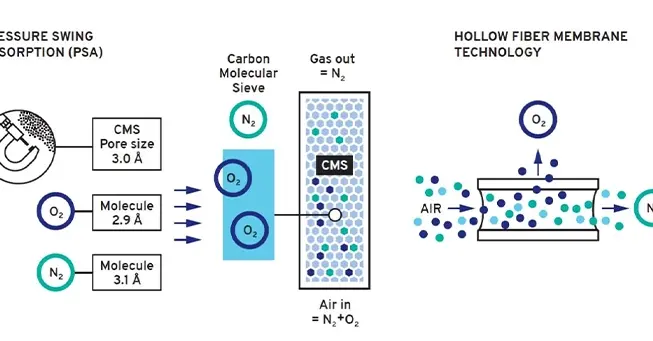5 reasons to choose a TMC feed-air (N2) compressor
The N2 feed-air compressor is the backbone of LNG cargo integrity. Make sure its quality reflects...
The main reason for the use of nitrogen on board vessels such as chemical tankers, product tankers and gas carriers is to replace the air atmosphere of the cargo tanks and adjacent space. This helps to prevent unwanted reactions between cargo and air, moisture pick-up and – worst case – fire explosion hazard.
There are two main types of nitrogen generators. One type uses pressure swing adsorption (PSA) process. The other type is based on hollow fibre membrane technology (see illustration below).
Both the PSA and membrane nitrogen systems utilise clean compressed air from a feed air compressor. The air is fed into the system where primarily the oxygen gas is separated from the air and vented to the atmosphere.
The result is that nitrogen at the required purity (95-99.9%) remains, ready for use or to be stored in a receiver serving as a buffer tank.
Firstly, a nitrogen system uses compressed air as its main source for producing nitrogen, regardless of whether it is based on the PSA or membrane technology. The correct feed air quality is therefore vital for maximising the lifetime of both PSA and membrane systems.
The effect of contaminated feed air into membranes or PSA media (CMS in illustration below), is that they will degrade over time and eventually lead to a costly replacement of either membranes or CMS in order to fulfil the class requirements of the nitrogen system.
We hope this article explains why N2 feed air compressors are vital for any nitrogen system.
5 reasons to chose a TMC feed-air (N2) compressor
Download our glossary: Understanding air compressors at sea
The N2 feed-air compressor is the backbone of LNG cargo integrity. Make sure its quality reflects...
TMC Compressors and Sauer Compressors have entered into a strategic cooperation agreement in...
Certain compressor systems are integral to your vessel’s functionality. Here’s how you avoid...
